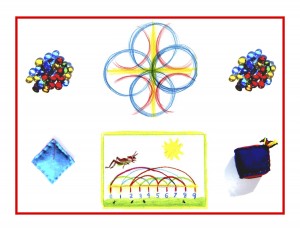Day 91
For one year, 365 days, this blog will address the Common Core Standards from the perspective of creating an alternate, ambient learning environment for math. Ambient is defined as “existing or present on all sides, an all-encompassing atmosphere.” And ambient music is defined as: “Quiet and relaxing with melodies that repeat many times.”
Why ambient? A math teaching style that’s whole and all encompassing, with themes that repeat many times through the years, is most likely to be effective and successful. In reviewing the eight Standards for Mathematical Practice Grade 1, I must say that I’m struck by how developmentally inappropriate they are. Today’s post will focus on the first pair of standards which will be listed in blue, followed by their ambient counterparts.
The Standards for Mathematic Practice, Grade 1
#1 and #6: Overarching habits of mind of a productive mathematical thinker.
1. Make sense of problems and persevere in solving them.
Math must make sense in and of itself. If it’s presented in an artistic and holistic way, the beauty of math is communicated and carries the day. It can be thought of as painless and inspiring and learned “all of a piece” rather than having to be taken apart and abstracted. When math is approached in this way, initiative builds in a natural way, and this leads to the initiative to solve problems! But ironically, there really are no problems (to quote John Lennon) there are “only solutions.” Joy in practicing mathematics leads to mastery, with no actual need for perseverance, because the sense that’s gained is so gratuitous, and therefore completely relevant within the child’s world.
6. Attend to precision.
No need to consciously attend to precision if math is allowed to be itself, in the presence of the child and the lesson. Expecting the 6-7 year old child to detach from this experience to the extent that s/he has to consciouslyrefocus is an artificial construct. If a child is given the gift of faith and trust in the process, the native, natural affinity for the subject will surface. So as a parent-teacher, your belief and confidence in the ability of the child, and in the magnetic beauty of math will be the true teacher, and will lead the child to real success in math. And beyond that practical goal, shows the child how to live in the world as a participant in the deepest sense.
For four days, each of the four pairs of Mathematical Practice Standards will be examined with an eye toward what works as developmentally appropriate math in Grade 1, continuing with standards 2 & 3. Knowledge ensues in an environment dedicated to imaginative, creative knowing, where student and teacher alike surrender to the ensuing of that knowledge as a worthy goal.












